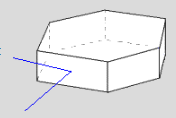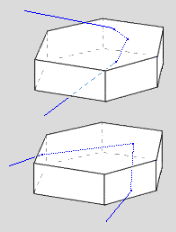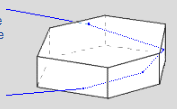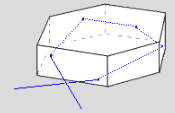Parhelic Circle Formation ~ A halo of many paths
Parhelic Circle Formation: A Halo of Many Paths
When sunlight or moonlight reflects from near-vertical faces of ice crystals, it gives rise to a fascinating atmospheric phenomenon known as the parhelic circle. This optical halo appears as a circular band of light encircling the sun or moon and is formed by a multitude of ray paths. While the parhelic circle may seem simple at first glance, it actually involves more ray paths than any other halo, making it a captivating subject for atmospheric optics enthusiasts.
The Contributions of External and Internal Reflections
The parhelic circle owes its existence to both external and internal reflections. External reflections play a significant role in the halo's formation, particularly when the rays graze the surface of the ice crystals. These reflections are most pronounced in the vicinity of the sun, contributing to the brightness of the parhelic circle in this region. On the other hand, rays that enter a crystal and undergo one or more internal reflections within it also make substantial contributions to the halo's intensity. These internally reflected rays create brightness opposite the sun, enhancing the overall appearance of the parhelic circle.
The Intricate Ray Paths of the Parhelic Circle
One of the intriguing aspects of the parhelic circle is the complexity of its ray paths. Let's explore some of these paths and their unique characteristics:
-
External Reflection: Rays reflect off any near-vertical face of an ice crystal, with grazing rays being particularly effective in contributing to the halo's appearance near the sun.
-
One Internal Reflection: Rays enter a nearly horizontal upper face of a crystal, reflect off a side face, and exit through a lower face. This path exhibits right-left symmetry.
-
Two Internal Reflections: The ray path becomes asymmetric, with entrance and exit rays making different angles to the crystal's faces.
-
Three Internal Reflections: This tortuous ray path adds to the halo's intensity away from the sun, creating intricate patterns.
-
Five Internal Reflections: This remarkable ray path travels right around the crystal, making it a significant contributor to the halo, even at locations far from the sun.
Exploring Ray Paths in Different Types of Ice Crystals
While the paths described above provide insight into the parhelic circle's formation in general ice crystals, it is important to note that other crystal shapes can produce additional ray paths. For example:
-
Plate Crystals: In plate-shaped ice crystals, there are even more ray paths to discover. These crystals offer unique possibilities for observing and understanding the formation of the parhelic circle.
-
Column Crystals: Further ray paths involve the near-vertical end faces of column-shaped ice crystals. Exploring these paths can provide a deeper understanding of the intricate nature of the parhelic circle.
Utilizing HaloSim for Ray Tracing
To explore and visualize the various ray paths contributing to the parhelic circle, one can utilize HaloSim, a ray-tracing software specifically designed for atmospheric optics simulations. By using the ray filters and tracer available in HaloSim, researchers and enthusiasts can delve into the complexities of the parhelic circle and gain valuable insights into its formation.
In conclusion, the parhelic circle is a captivating halo formed by sunlight or moonlight reflecting from near-vertical faces of ice crystals. While it may appear simple, this halo actually involves a multitude of intricate ray paths, making it one of the most complex atmospheric optical phenomena. By understanding the contributions of external and internal reflections and exploring the ray paths in different types of ice crystals, we can gain a deeper appreciation for the beauty and complexity of the parhelic circle.
The parhelic circle is produced when sunlight or moonlight reflects from near vertical faces of ice crystals.
Plate, horizontal columns and Parry oriented crystals all make it.
The reflection from the outside of a crystal or one more times within it.
The parhelic circle appears simple yet more ray paths contribute to it than in any other halo. Some are very intricate.
External and internal reflections make the parhelic circle. External reflections contribute most near the sun. Rays reflected once inside a crystal produce much of the halo intensity. Opposite the sun, rays internally reflected twice or more add their brightness. The relative contributions depend on the sun's altitude and the crystal thickness. Unfiltered (left) and filtered (right) fisheye HaloSim ray tracings for a 30� high sun.
External reflection
Rays reflect off any near-vertical face. Most effective when rays graze the surface. They therefore contribute most near to the sun

1 internal reflection
Rays enter a nearly horizontal upper face, reflect off a side face and leave through a lower face.

A route through side faces only. The ray path has right-left symmetry.
2 internal reflections
The ray path is asymmetric, the entrance and exit rays make different angles to the faces.

3 internal reflections
A tortuous path contributing to intensity away from the sun.

5 internal reflections
This ray travels right around the crystal. Another contributor far from the sun.

There are even more ray paths in plate crystals and further ones involving the near vertical end faces of column crystals! Find them with HaloSim by using the ray filters and the ray tracer.
Note: this article has been automatically converted from the old site and may not appear as intended. You can find the original article here.
Reference Atmospheric Optics
If you use any of the definitions, information, or data presented on Atmospheric Optics, please copy the link or reference below to properly credit us as the reference source. Thank you!
-
<a href="https://atoptics.co.uk/blog/parhelic-circle-formation-a-halo-of-many-paths/">Parhelic Circle Formation ~ A halo of many paths</a>
-
"Parhelic Circle Formation ~ A halo of many paths". Atmospheric Optics. Accessed on April 27, 2024. https://atoptics.co.uk/blog/parhelic-circle-formation-a-halo-of-many-paths/.
-
"Parhelic Circle Formation ~ A halo of many paths". Atmospheric Optics, https://atoptics.co.uk/blog/parhelic-circle-formation-a-halo-of-many-paths/. Accessed 27 April, 2024
-
Parhelic Circle Formation ~ A halo of many paths. Atmospheric Optics. Retrieved from https://atoptics.co.uk/blog/parhelic-circle-formation-a-halo-of-many-paths/.